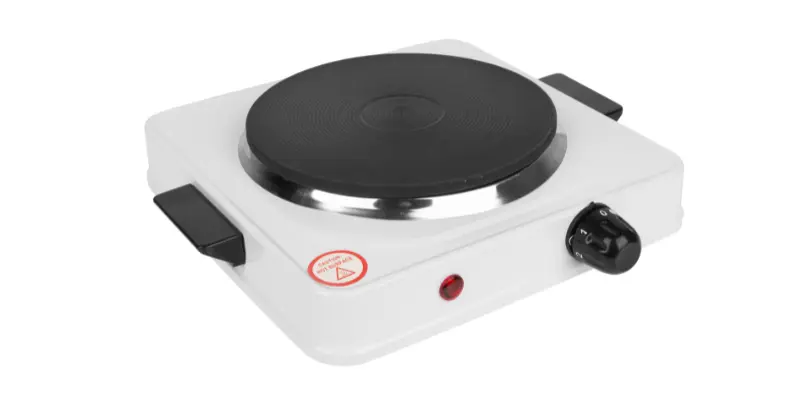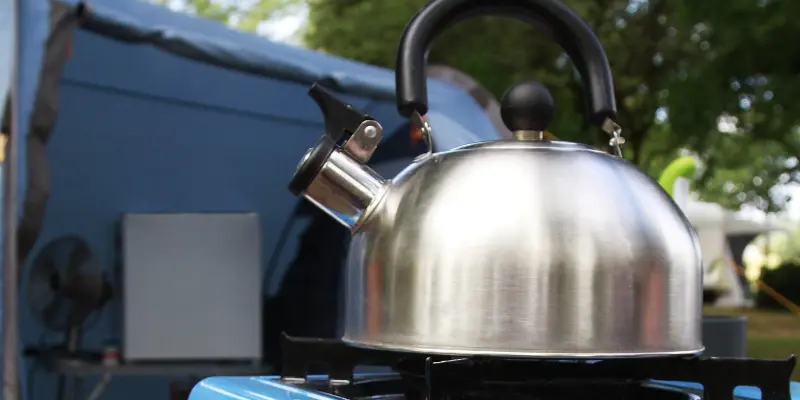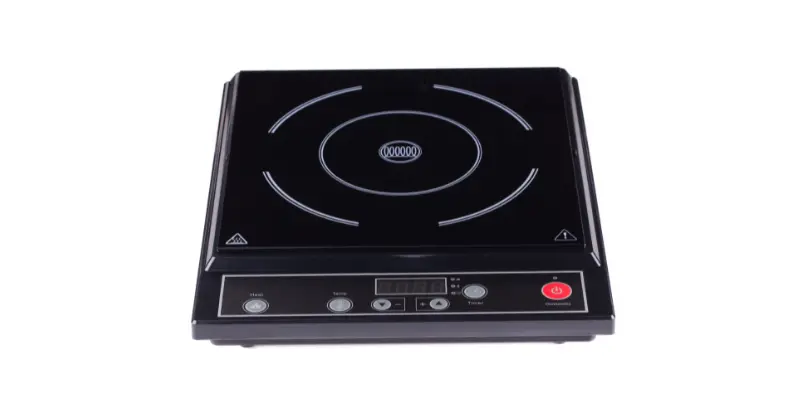Electric Camp Stove Guide: Cook Smarter in the Wild
Updated: 27 Jun 2025
226
Ever wondered why so many campers are ditching gas stoves for electric ones? It’s not just about convenience. Today’s outdoor adventurers want gear that’s clean, safe, and simple. And the truth is, traditional stoves with open flames are messy, risky, and often banned in many camping areas.

If you’ve ever struggled with fuel leaks, fire bans, or soggy wood, you know the frustration. The good news? There’s a better way. A portable electric camp stove offers a cleaner, safer alternative without sacrificing cooking power.
In this post, you’ll learn everything about choosing the best electric camp stove, how it works, what features to look for, safe power options, and smart comparisons to other stoves—so you can decide if an eco-friendly electric camp stove is right for your next trip.
What Is an Electric Camp Stove?
An electric camp stove is a modern, flame-free cooking device designed for outdoor use. Instead of gas or wood, it runs on electric power—either from a plug-in, power bank, or portable battery station. Just plug it in, place your pot, and start cooking. That’s it.
Unlike traditional stoves, there’s no open flame, smoke, or fuel leakage. This makes it safer for tent cooking, use in fire-ban zones, or trips with kids and pets. Most models are lightweight and easy to carry.
Whether you’re car camping, glamping, or living the van life, switching to an eco-friendly electric camp stove makes outdoor meals simpler, safer, and way more enjoyable.
How Does an Electric Camp Stove Work?
An electric camp stove works just like the electric burner at home, but in a compact, portable form. Here’s how it functions:
- Power Supply – It draws energy from a wall outlet, portable power station, or solar generator. Some models also support USB or car inverter use.
- Heating Mechanism – The electric coil or glass-ceramic surface warms up when powered. It transfers heat directly to your cookware.
- Temperature Control – Most units include dials or digital controls to adjust the heat level.
- Built-In Safety – Many come with features like overheat protection, cool-touch exteriors, and non-slip feet for safer cooking.
Key Features to Look for in an Electric Camp Stove
Not all electric camp stoves are built the same. Choosing the right one means knowing what features matter most for outdoor cooking. Here’s what to look for:
1. Power Compatibility
Common types include:
- 110–120V AC plug (campground hookups or inverters)
- 12V DC adapters (car camping)
- USB-powered models (very low wattage)
- Battery or solar generator-compatible units
2. Wattage
The wattage of your stove affects how fast and hot your stove gets.
- 600–800W – Ideal for boiling water, heating soup, or light cooking
- 1000–1500W – Better for frying, simmering, and full meals
- More wattage = faster cooking, but higher power use
3. Portability and Size
Look for a small electric stove for camping that fits your storage needs:
- Foldable handles or legs
- Lightweight design (under 5 lbs)
- Compact dimensions (under 12 inches wide)
4. Cooking Surface
Choose a surface that heats evenly and is easy to clean:
- Ceramic Glass – Sleek, even heat, but delicate
- Stainless Steel – Durable and scratch-resistant
- Non-stick Coating – Easier cleanup with less oil
5. Safety Features
Modern stoves come with built-in safety tech:
- Auto shut-off
- Overheating protection
- Heat-resistant handles
- Non-slip rubber feet
- Cool-touch exteriors
You can also follow electric stove safety guidelines.
Best Use Cases for an Electric Camp Stove
The beauty of an electric camp stove is its versatility. Here’s where these stoves shine:
1. Campgrounds with Power Hookups

Many public and private campsites offer electric outlets. Plug in your stove and start cooking—no fuel, no mess.
Perfect for: Family trips, RV parks, Tent camping with amenities
Use case: Make a full breakfast (eggs, toast, coffee) without waking the neighbors with a propane hiss.
2. Van Life & RV Camping
Electric stoves for van life are becoming the go-to choice. They’re compact, clean, and pair well with solar or battery power systems.
Great for: Nomads, Digital nomads, Off-grid travelers
These stoves keep your van interior free from propane fumes.
3. Fire-Ban Zones
In high-risk wildfire areas, open flame cooking is banned. But many parks still allow camping electric stoves due to their safety.
Ideal for: National forests, Drought-prone states (CA, CO, AZ), Burn-restricted areas
4. Cabins and Indoor Use
Cold or rainy outside? An indoor-safe electric camp stove is perfect for backup cooking. No ventilation needed, no fuel storage issues.
Also useful in: Tiny homes, Emergency backup setups, Backyard patio kitchens
Pros and Cons of Portable Electric Camp Stoves
Before you buy, let’s break down the honest pros and cons.
Pros
- Flame-Free Cooking: No fire risk, no smoke, no CO2.
- Eco-Friendly Choice: Lower carbon footprint than gas or wood.
- User-Friendly: Just plug in and cook—no lighter or fuel needed.
- Versatile Power Options: Compatible with solar, car inverters, and wall outlets.
- Indoor-Safe: Can be used in cabins, tents (with care), or even your garage.
- Lightweight & Compact: Easy to store and travel with.
Cons
- Requires Electricity: Useless without a power source. Not for deep wilderness unless you bring power.
- May Heat Slower Than Flame: Especially on windy days or high altitudes.
- Limited Cookware Compatibility: Some stoves don’t work with heavy iron or warped pans.
- Battery Drain: High wattage drains small power stations quickly.
Best Power Sources for Electric Camp Stoves
A reliable power source is key to using an electric stove for camping. Here are the most trusted options:

1. Portable Power Stations
These are rechargeable battery packs designed for outdoor use.
Top brands:
- Jackery Explorer 500
- Bluetti EB3A
- Goal Zero Yeti 500X
They’re powerful enough to run your camping electric stove for several meals.
2. Solar Generators
Use solar panels to charge your power station during the day, then cook at night. Good for eco-conscious campers and off-grid setups.
3. Car Inverters
Use your car battery via a 12V inverter to power your stove. Great for short trips, though prolonged use may drain your car battery.
4. Campground Hookups
If you’re staying in a powered site, this is the easiest option. Just plug in and cook. Always check your stove’s wattage and your power source’s capacity.
Buying Guide: Top Electric Camp Stove Models
Before you buy, compare the best camping electric stove models based on size, power, and portability.
| Model | Wattage | Weight | Power Source | Best For |
|---|---|---|---|---|
| CampPro Mini Burner | 800W | 2.8 lbs | Wall/Power Bank | Tent Cooking |
| Jackery CookMate 1000 | 1000W | 4.5 lbs | Battery | Van Life + RVs |
| EcoHeat Portable Stove | 600W | 2.2 lbs | USB/Solar | Backpacking |
| HeatMate Max 1500 | 1500W | 6.2 lbs | AC/Generator | Group Cooking + Cabins |
Check out our detailed guide on the best electric stove
Tips for Using an Electric Stove While Camping
Here are some pro tips to make the most of your camping electric stove:
- Use it on a flat, heat-proof surface
- Cook with a lid to trap heat
- Always keep cords dry
- Use wind protection when outdoors
- Let the unit cool before packing
- Don’t overload your power source
- Bring a backup power bank just in case
What Can You Cook on an Electric Camp Stove?
A portable camping electric stove can handle more meals than you might expect.

Here’s a list of easy and tasty camping meals you can cook:
- Scrambled eggs with toast
- Pasta with sauce
- Instant noodles or oatmeal
- Grilled cheese sandwiches
- Stir-fried veggies
- Coffee or tea using a kettle
- Pancakes or quesadillas
- One-pot rice dishes
Electric vs Gas vs Wood vs Solar: What’s Best?
| Stove Type | Safe | Clean | Eco-Friendly | Needs Fuel | Indoor Use |
|---|---|---|---|---|---|
| Electric | Yes | Yes | Yes | No | Yes |
| Gas (Propane) | ⚠️ | No | No | Yes | No |
| Wood Burning | ⚠️ | No | No | Yes | No |
| Solar Cooker | Yes | Yes | Yes | Yes(Sun) | No |
Verdict: For safety, portability, and modern convenience, a portable electric stove for camping is a top pick, especially where open flames are banned.
FAQs
1. Can an Electric Camp Stove Be Used in a Tent?
Yes—only if ventilation is good and the stove is designed for indoor use. Use heat-resistant mats and place them on a flat surface.
2. Is It Safe for Kids and Pets?
Absolutely. Since there’s no flame, no fuel, and cool-touch sides (in most models), it’s a safer pick. But always supervise when in use.
3. Can I Bring an Electric Stove on a Plane?
No, not in carry-on. But many airlines allow it in checked baggage. Always check with your airline.
FAA Travel with Electronics
4. What’s the Best Cookware Material?
Use non-stick, stainless steel, or anodized aluminum. Avoid oversized or warped pans—they heat unevenly.
5. Will It Work in Windy or Cold Areas?
Yes, but cooking may take longer. Wind reduces efficiency. Use a windshield or cook inside a covered area where possible.
Final Verdict: Should You Buy an Electric Camp Stove?
An electric camp stove is the perfect solution for modern campers who want safe, clean, and easy outdoor cooking. It doesn’t need gas or fire, making it ideal for campgrounds, fire-restricted zones, and van life.
With the right power source, like a portable battery or solar generator, you can enjoy hot meals anywhere, without the hassle of fuel or smoke. It’s also safer for kids and pets, easy to use, and works well in many camping situations.
If you want a more eco-friendly, flame-free alternative to gas or wood stoves, this is your best bet. It’s simple, reliable, and built for today’s camper.
References
https://www.energystar.gov/products/electric_cooking_products
Please Write Your Comments